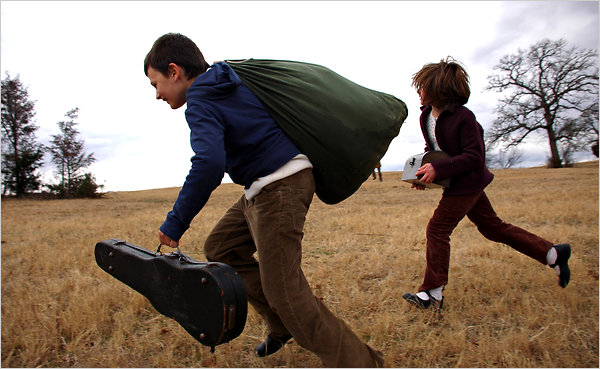David Lowery’s first feature film, St. Nick, opens with a static shot that begins to slowly zoom out, showing a boy breaking into an abandoned house. Golden sunlight filters into the dusty residence. Other than a few creaks caused by the youthful intruder, the film stays quiet, observant. The boy is quite young, about eleven years old, but seemingly well-equipped for the task. St. Nick captures his break-and-enter accomplishment in unobtrusive, real-time filming, as the boy silently and determinedly checks out the house as if he were intent on renting the place. This is not faux-adult posturing, however; he is there to find a makeshift home, and ends up squatting in the derelict house with his younger sister (the boy, aged eleven, and the girl, aged eight, are played by real-life siblings Tucker and Savanna Sears). The majority of St. Nick shows them turning the little wooden shack into their own hidden fortress, configuring a small old-fashioned stove for heat, building blanket forts, and finding old furniture on nearby yard curbs.
The ease with which the kids, particularly the brother, manage their self-efficiency would indicate that they’ve gotten by for some time. Yet there remains a vulnerability and ignorance in their approach to independence, and it forces the viewer to question their circumstances. The precariousness of their survival seems predicated by their young age, which is not likely to change anytime soon. For example, early on, the boy finds groceries fit for sandwiches while dumpster diving. These supplies will only last for so long, yet the children do not seem worried about how they will feed themselves in the future. Later they begin to shoplift from a convenience store, taking things like bread, peanut butter, marshmallows. The girl makes a towering sandwich stack of these three ingredients and then tries to bite into it, her face a greasy mess. It’s kind of adorable but sad, because this is a child’s idea of survival. In a similar scene in which the kids discover the bones of a dog in the yard, the girl decides to name it Donut, puts it in a wooden toy carriage name, and lugs it around with her, acting as if it were a real dog.
Are these survivors of child abuse? Perhaps they’re orphans. Did they run away from a foster home, or did they unwillingly witness or partake in a crime? St. Nick is uninterested in answering these questions. The film focuses its energies instead on the minutiae of their actions as they try to find a suitable new shelter, the camera framing their small, slight frames in an ominous world that must contain them, one set in an unidentified Southwestern suburb. The visual compositions show a mostly desolate place in which the children are constantly moving and crafting and searching, their faces lost in constant thought or concentration as they work on a task. The elliptical storytelling, with the camera angled on small, seemingly meaningless details—like the small delicate bones of Donut, or a hole in the girl’s sweater—are reminiscent of Terrence Malick, yet these shots are distinct enough to demonstrate that Lowery is creating his own cinematic grammar. The cinematography gives the film a sensibility that avoids the typical portraiture of unique child characters, and this prevents the characters’ precociousness from seeming too idealized or wondrous. The boy and girl are fascinating, but sad in their own mysterious ways.
Their adventure ends up being a fleeting runaway scheme, something that is revealed at the end of the film, yet it takes up much of the narrative length and initially gives the illusion that they’ve been on the run for some time. That the children don’t seem too disturbed by their circumstances and are mostly complacent normalizes the scenario, and the film seems equally content in showing us the kinds of child activities that keep the two busy.
Without school or toys, the two spend their time trying to survive or just engaging in the kind of leisurely kid-play that boredom lends, like scratching and marking wooden panels in the house. The girl tries to ride the bike the two found on a yard curb, a rusty old thing with a high seat. The camera stays on her as she repeatedly tries to work the pedals and fly down the road. Eventually she succeeds and crashes a kid’s birthday party set in a playground. Blending in with the rest of the children, she is offered cake and gladly accepts, delicately yet quickly eating in that kind of stoic, quiet way kids sometimes employ when they know they might be doing something wrong. Her delight in finding new friends and iced sugar is irresistible, but she’s brought back to reality and realizes she must immediately leave when the adults begin to question her about her family.
Skirmishes with adults feel terrifying, and the silence and apathy of our helpless protagonists in their encounters with older, bigger, potentially threatening characters only fill us with more dread. That we, as viewers, are driven to feel danger in these scenes, instead of a sense of relief, in that adult characters could try to aid these two kids, is a very deliberate point the film makes so discreetly it’s almost easy to miss. St. Nick retains its mysterious nature right to the end of the film when the children are found out and forced to return to their family home. Here, we still see nothing of childhood horrors that might convince a boy to leave. There’s no abuse or neglect from the parents, yet something remains off, something is wrong. St. Nick works best when it communicates this information in small, silent moments, like when the boy rubs his wet eyes while trying to sleep. This is a childhood experience so lonely and so alarming that the film cannot articulate it into words, only quiet emotions. St. Nick shields us from the depths of such sadness by internalizing it in the minds of its characters, who may be young, but they’re also quite tenacious. That kind of strength is admirable and it fills one with hope.

